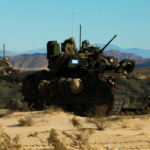
Pentagon technology chief Michael Griffin said April 17 that he wants to field a megawatt-class, directed energy (DE) device in space by the late 2020s to protect the United States against hostile long-range missiles.And “within a few years,” he wants to have a 100-kilowatt-class laser that can be deployed on an Army Stryker vehicle and a “several-hundred-kilowatt directed energy capability” that can be installed for defensive purposes on an Air Force tanker, Griffin testified before the House Armed Services Committee…

 By
By 











